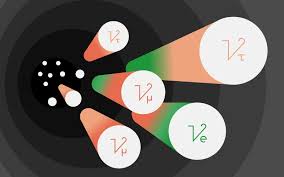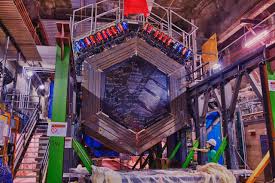Virtual Neutrino Workshop - Facilitator Resources 2020

Summer 2020
University of Everywhere
Objectives
Participating teachers will:
- Apply physics principles to reduce or explain the observations in data investigations.
- Examine simulated and experimental data. Identify patterns within the data and consider causes of those patterns.
- Create, organize and interpret data plots; make claims based on evidence and provide explanations; identify data limitations.
- Develop a plan for taking students from their current level of data use to subsequent levels using activities and/or ideas from the workshop.
We will also provide opportunities to engage in critical dialogue among teaching colleagues about what they learn in the workshop.
For more details, see the Nu Notes document or Nu Notes pdf attached below.
2 Day Version, 1.5 Day Version, 1 Day Version
2 Day Version
Day 1 Agenda
| Activity | 2 Day Version | Remarks |
|---|---|---|
|
Pre-Workshop
|
09:00-9:30 | |
|
Introduce neutrinos
|
09:30-9:45 | |
|
Mean Lifetime: Part 1 Dice - Level 1 Data Portfolio Activity “What is the most likely number of throws necessary to produce a “1” on the top of a 6-sided die?”
|
9:45-10:00 | |
|
Participants conduct “1-die Decay” Simulation with a real |
10:00-10:45 | |
| BREAK | Take a break before 10:45 when convenient for you. | |
|
Discuss why “One throw” is the answer to the initial question. |
10:45-11:00 | |
|
Mean Lifetime Part 3: MINERvA - Level 2 Data Portfolio Activity Introduce MINERvA experiment, ARACHNE data display (link may not work in all browsers), and muon-lifetime and electron-energy data collection. |
11:00-11:45 | |
|
Videoconference Pause
Optional "Office Hour"
|
11:45-14:00 | |
|
Make muon-lifetime histogram, plot histogram data to determine muon mean lifetime.
|
14:00-14:30 | |
|
Discuss Michel electron energy results. Google slides.
|
14:30-14:45 | |
|
“Neutrinos: Mystery and History” presentation |
14:45-15:45 | |
|
Reflections on day’s activities |
15:45-16:00 | |
Day 2 Agenda
| Activity | 2 Day Version | Remarks |
|---|---|---|
| Welcome back and opening discussion | 09:00-9:30 | |
|
The Case of the Hidden Neutrino - Level 1 Data Portfoio Activity OR “Mean Lifetime Part 2: Cosmic Muons” Level 2 Data Portfolio Activity. How do we know that our cosmic ray detectors are detecting muons? |
09:30-10:15 | |
| Discuss activity results | 10:15-10:30 | |
| Break | 10:30-10:45 | |
|
Present “What Heisenberg Knew” Level 1 Data Portfolio Activity. |
10:45-11:00 | |
|
Engage in “What Heisenberg Knew” Level 1 Data Portfolio Activity. |
11:00-11:45 | |
|
Discuss activity results. |
11:45-12:00 | |
|
"How do we use neutrinos to measure neutron momentum in a nucleus?” |
12:00-12:15 | |
|
12:15-14:15 | |
|
Discuss MINERvA “Momentum Conservation” activity results.
|
14:15-14:45 | |
| Moderator presents information on current neutrino experiments. | 14:45-15:15 | |
|
Implementation Plan using these instructions. |
15:15-16:15 | |
|
Survey |
16:15-16:30 | |
| End of workshop | 16:30 | Neutrino Resources |
2 Day Version, 1.5 Day Version, 1 Day Version
1.5 Day Version
Day 1 Agenda
| Activity | 1.5 Day Version | Remarks |
|---|---|---|
|
Pre-Workshop
|
09:00-9:30 | |
|
Introduce neutrinos
|
09:30-9:45 | |
|
Mean Lifetime: Part 1 Dice - Level 1 Data Portfolio Activity “What is the most likely number of throws necessary to produce a “1” on the top of a 6-sided die?”
|
9:45-10:00 | |
|
Participants conduct “1-die Decay” Simulation with a real |
10:00-10:45 | |
| BREAK | Take a break before 10:45 when convenient for you. | |
|
Discuss why “One throw” is the answer to the initial question. |
10:45-11:00 | |
|
Mean Lifetime Part 3: MINERvA - Level 2 Data Portfolio Activity Introduce MINERvA experiment, ARACHNE data display (link may not work in all browsers), and muon-lifetime and electron-energy data collection. |
11:00-11:45 | |
|
Videoconference Pause
Optional "Office Hour"
|
11:45-14:00 | |
|
Make muon-lifetime histogram, plot histogram data to determine muon mean lifetime.
|
14:00-14:30 | |
| Discuss Michel electron energy results. Google slides. Muon decay produces two neutrinos. Lepton flavor number is conserved.
|
14:30-14:45 | |
|
“Neutrinos: Mystery and History” presentation |
14:45-15:45 | |
|
Reflections on day’s activities |
15:45-16:00 | |
Day 2 Agenda (of the 1.5 Day Version)
| Activity | 1.5 Day Version | Remarks |
|---|---|---|
| Welcome back and opening discussion | 09:00-9:30 | |
|
The Case of the Hidden Neutrino - Level 1 Data Portfoio Activity OR “Mean Lifetime Part 2: Cosmic Muons” Level 2 Data Portfolio Activity. How do we know that our cosmic ray detectors are detecting muons? |
09:30-10:15 | |
| Discuss activity results | 10:15-10:30 | |
| Break | 10:30-10:45 | |
|
Moderator presents some current neutrino experiments |
10:45-11:15 | |
|
Implementation Plan using these instructions. |
11:15-12:15 | |
|
Survey/End of Workshop |
12:15-12:30 |
2 Day Version, 1.5 Day Version, 1 Day Version
1 Day Version
Day 1 Agenda
| Activity | 1 Day Version | Remarks |
|---|---|---|
|
Pre-Workshop
|
09:00-9:30 | |
|
Introduce neutrinos
|
09:30-9:45 | |
|
Mean Lifetime: Part 1 Dice - Level 1 Data Portfolio Activity “What is the most likely number of throws necessary to produce a “1” on the top of a 6-sided die?”
|
9:45-10:00 | |
|
Participants conduct “1-die Decay” Simulation with a real |
10:00-10:45 | |
| BREAK | Take a break before 10:45 when convenient for you. | |
|
Discuss why “One throw” is the answer to the initial question. |
10:45-11:00 | |
|
Mean Lifetime Part 3: MINERvA - Level 2 Data Portfolio Activity Introduce MINERvA experiment, ARACHNE data display (link may not work in all browsers), and muon-lifetime and electron-energy data collection. |
11:00-11:45 | |
|
Videoconference Pause
Optional "Office Hour"
|
11:45-13:45 | |
|
Make muon-lifetime histogram, plot histogram data to determine muon mean lifetime.
|
13:45-14:00 | |
| Discuss Michel electron energy results. Google slides. Muon decay produces two neutrinos. Lepton flavor number is conserved.
|
14:00-14:15 | |
|
“Neutrinos: Mystery and History” presentation |
14:15-15:15 | |
| Moderator presents information on current neutrino experiments. | 15:15-15:45 | |
| Implementation Plan using these instructions. | 15:45-16:45 | |
|
Survey/End of Workshop |
16:45-17:00 | Neutrino Resources |

